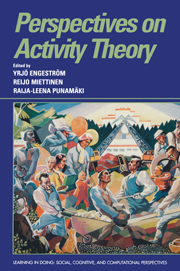Book contents
- Frontmatter
- Contents
- List of contributors
- Series foreword
- Introduction
- Part I Theoretical issues
- 1 Activity theory and individual and social transformation
- 2 The content and unsolved problems of activity theory
- 3 Knowledge as shared procedures
- 4 Activity theory in a new era
- 5 Society versus context in individual development: Does theory make a difference?
- 6 Cultural psychology: Some general principles and a concrete example
- 7 Laws, logics, and human activity
- 8 Collapse, creation, and continuity in Europe: How do people change?
- 9 Activity theory and the concept of integrative levels
- 10 The relevance to psychology of Antonio Gramsci's ideas on activity and common sense
- Part II Language and its acquisition
- Part III Play, learning, and instruction
- Part IV Technology and work
- Part V Therapy and addiction
- Author index
- Subject index
1 - Activity theory and individual and social transformation
Published online by Cambridge University Press: 05 June 2012
- Frontmatter
- Contents
- List of contributors
- Series foreword
- Introduction
- Part I Theoretical issues
- 1 Activity theory and individual and social transformation
- 2 The content and unsolved problems of activity theory
- 3 Knowledge as shared procedures
- 4 Activity theory in a new era
- 5 Society versus context in individual development: Does theory make a difference?
- 6 Cultural psychology: Some general principles and a concrete example
- 7 Laws, logics, and human activity
- 8 Collapse, creation, and continuity in Europe: How do people change?
- 9 Activity theory and the concept of integrative levels
- 10 The relevance to psychology of Antonio Gramsci's ideas on activity and common sense
- Part II Language and its acquisition
- Part III Play, learning, and instruction
- Part IV Technology and work
- Part V Therapy and addiction
- Author index
- Subject index
Summary
Introduction
The internationalization of activity theory in the 1980s and 1990s has taken place in the midst of sweeping changes in the political and economic systems of our planet. During a few months, the Berlin Wall came down and Nelson Mandela was freed from prison. Those were only two among the visible symbols of the transformations that continue to amaze the most sophisticated observers.
Many of the current changes share two fundamental features. First, they are manifestations of activities from below, not just outcomes of traditional maneuvering among the elite of political decision makers. Second, they are unexpected or at least very sudden and rapidly escalating. These two features pose a serious challenge to behavioral and social sciences.
The behavioral and social sciences have cherished a division of labor that separates the study of socioeconomic structures from the study of individual behavior and human agency. In this traditional framework, the socioeconomic structures look stable, all-powerful, and self-sufficient. The individual may be seen as an acting subject who learns and develops, but somehow the actions of the individual do not seem to have any impact on the surrounding structures.
This traditional dualistic framework does not help us to understand today's deep social-transformations. More than ever before, there is a need for an approach that can dialectically link the individual and the social structure. From its very beginnings, the cultural-historical theory of activity has been elaborated with this task in mind.
- Type
- Chapter
- Information
- Perspectives on Activity Theory , pp. 19 - 38Publisher: Cambridge University PressPrint publication year: 1999
- 1123
- Cited by



